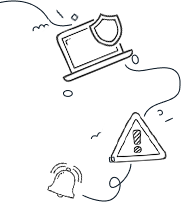Introduction
When it comes to ransomware attacks, it seems like 66% of organizations are saying, “Why not us?” and willingly putting their hands up. The average ransom demanded in 2024 has shockingly exceeded $2.5 billion. With AI strutting its stuff and threat actors coming up with new ways to play hide-and-seek with your data, the situation isn’t getting any rosier.
So, how did we stumble into this cyber quagmire? Buckle up as we embark on a roller-coaster ride through the history of ransomware, the current climate, and the future — which, spoiler alert, is looking a bit unnerving.
The Birth of Ransomware
While ransomware has been waving its dramatic flag since the 80s, the true “birth of modern ransomware” can be traced back to 2013, when the infamous Cryptolocker made its grand entrance. This was the malware equivalent of a magician pulling a rabbit out of a hat, except in this case, the rabbit was your data locked away until you handed over cash.
Enter stage left: a heroic international effort—Operation Tovar! In late May 2014, this brave band of online warriors took down Cryptolocker by targeting the botnet infrastructure like a team of cyber ninjas. They even walked away with the keys to the vault, allowing victims to breathe a sigh of relief as they reclaimed their files without paying the ransom. Claps for the cyber knights!
Fast forward a decade, and we’ve got a ransomware situation that’s not just complex — it’s practically the plot of a suspense thriller.
The Current Threat
Today’s ransomware has upped the ante, employing encryption methods that make Fort Knox look like a kiddie piggy bank. Many also combine encryption with data theft, because why go simple when you can have a two-for-one deal? Now, most of them like to play a game called double extortion, threatening to air your dirty laundry (i.e., stolen data) if you don’t pay up. Fancy that!
But wait, there’s more! Threat actors have taken it a step further with triple extortion. Who doesn’t love a good upgrade on a hijacking? They might not only threaten your data but also knock your service offline with a DDOS attack or go after your clients and partners — the cyber equivalent of taking your lunch money and your lunch.
And how do they get this ransomware? Enter AI, turning what used to take hours of coding into something that could fit into a TikTok video. Meanwhile, on the dark web, crooks are living their best lives buying ransomware-as-a-service (RaaS) packages complete with user manuals and even tech support! Forget about the golden age of innovation; it’s the golden age of cyber villainy!
The Future of Ransomware
Of course, with great power comes great responsibility — and organizations are gearing up for battle. Advanced cybersecurity measures are on the horizon, including AI-driven threat detection and response systems, which will put the proverbial spanner in the works of those cyber miscreants. Keeping ahead of evolving threats is key to staying safe in this wild west of the digital realm.
Conclusion
While early ransomware mainly had a flair for targeting individuals, the gloves have come off, and now organizations and supply chain vendors are in the crosshairs. The ransom amounts are getting serious too, averaging over $2.5 million in 2024 — no small change! The bad guys are everywhere, launching high-profile attacks that would put even the worst action movies to shame.
Yet, while ransomware evolves and throws curveballs our way, so do our defenses. Training on how to report and respond to ransomware, stressing the importance of NOT paying up, remains crucial. Think of strategies like end-to-end encryption, best practices on data privacy, and security awareness trainings as your digital armor against ransomware!
Though the specifics may shift like sand, the basics of security will always stand strong. We must treat our PII like a priceless art piece—guard it with your life!
So, buckle up and stay protected against the ever-evolving storm of cyber threats looming over our systems!
The post Ransomware: Past, Present and Future appeared first on .




